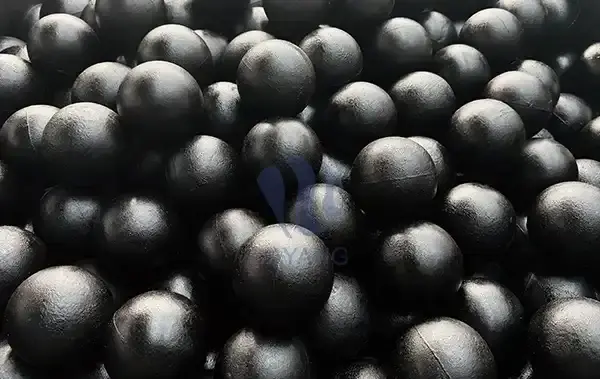Types of Ball Mill Grinding Media
High Chrome Cast Iron Balls
High chrome cast iron balls are a popular choice for ball mill grinding media due to their exceptional wear resistance and durability. These balls typically contain 10-30% chromium content, which contributes to their superior hardness and ability to withstand abrasive environments. The high chromium content also results in the formation of carbides, further enhancing their wear resistance properties.
Key features of high chrome cast iron balls include:
- Excellent wear resistance
- High hardness (typically 60-65 HRC)
- Good impact resistance
- Suitable for grinding abrasive materials
- Cost-effective for long-term use
These balls are particularly well-suited for applications in cement production, mineral processing, and other industries where highly abrasive materials are processed. Their ability to maintain their shape and size over extended periods of use contributes to consistent grinding performance and reduced media consumption.
Low Chrome Cast Steel Balls
Low chrome cast steel balls offer a balance between hardness and toughness, making them versatile grinding media for various applications. These balls typically contain 1-3% chromium content, which provides improved wear resistance compared to standard carbon steel balls while maintaining good impact strength.
Characteristics of low chrome cast steel balls include:
- Good wear resistance
- Moderate hardness (typically 55-60 HRC)
- Excellent impact resistance
- Suitable for a wide range of grinding applications
- Cost-effective option for many industries
Low chrome cast steel balls are commonly used in mining operations, cement production, and other industries where a combination of wear resistance and toughness is required. Their versatility makes them a popular choice for various grinding applications, from coarse to medium grinding tasks.
Forged Steel Balls and Ceramic Balls
Forged Steel Balls
Forged steel balls are manufactured through a process of hot forging, which results in a uniform microstructure and superior mechanical properties. These Ball Mill Grinding Media are known for their high strength, toughness, and resistance to deformation, making them ideal for heavy-duty grinding operations.
Key attributes of forged steel balls include:
- High impact strength
- Excellent wear resistance
- Uniform hardness throughout the ball
- Suitable for high-energy grinding applications
- Long service life in demanding environments
Forged steel balls are extensively used in mining and mineral processing industries, particularly in primary and secondary grinding stages where high impact forces are encountered. Their ability to withstand heavy loads and maintain their spherical shape contributes to efficient grinding and reduced media consumption over time.
Ceramic Balls
Ceramic balls, while less common than their metallic counterparts, offer unique advantages in specific grinding applications. These balls are typically made from materials such as alumina, zirconia, or silicon nitride, each providing distinct properties suited for different grinding requirements.
Advantages of ceramic balls include:
- High wear resistance
- Low density (compared to steel balls)
- Chemical inertness
- Suitable for fine and ultra-fine grinding
- Ideal for applications requiring minimal contamination
Ceramic balls are often employed in specialized industries such as electronics, pharmaceuticals, and advanced materials processing, where product purity and fine particle size distribution are critical. Their chemical inertness makes them suitable for grinding corrosive or reactive materials without the risk of contamination.
How do different types of grinding media affect ball mill performance?
Impact on Grinding Efficiency
The choice of grinding media significantly influences the overall efficiency of ball mill operations. Different types of grinding media exhibit varying levels of hardness, toughness, and wear resistance, which directly impact the grinding process. For instance, high chrome cast iron balls, with their superior hardness and wear resistance, are particularly effective in maintaining their size and shape over extended periods, ensuring consistent grinding performance. This characteristic is especially beneficial in processing highly abrasive materials, as it minimizes the need for frequent media replacement and reduces downtime. Forged steel balls, known for their high impact strength, excel in applications where powerful crushing forces are required. Their ability to withstand heavy loads without significant deformation contributes to efficient size reduction, particularly in the early stages of grinding. On the other hand, ceramic balls, with their lower density and high wear resistance, can be advantageous in fine grinding applications. Their lighter weight allows for higher ball charge volumes, potentially increasing the grinding capacity for certain materials.
Energy Consumption and Cost Considerations
The type of Ball Mill Grinding Media used also plays a crucial role in determining the energy consumption of ball mill operations. Heavier media, such as high chrome cast iron or forged steel balls, require more energy to lift and cascade within the mill. However, their higher weight and impact force can lead to more efficient grinding, potentially reducing the overall grinding time and energy consumption per unit of material processed. Ceramic balls, being lighter, may require less energy for motion within the mill but might necessitate longer grinding times to achieve the desired particle size reduction. The trade-off between media weight, grinding efficiency, and energy consumption must be carefully evaluated based on the specific requirements of each application. Cost considerations extend beyond the initial purchase price of the grinding media. Factors such as wear rate, replacement frequency, and impact on mill lining wear all contribute to the total operational cost. While high-quality grinding media may have a higher upfront cost, their extended service life and consistent performance can result in long-term cost savings through reduced maintenance and replacement needs.
In conclusion, the selection of appropriate ball mill grinding media is a critical decision that impacts various aspects of milling operations, from grinding efficiency and energy consumption to product quality and operational costs. By understanding the unique properties and applications of different types of grinding media, industries can optimize their ball mill performance and achieve superior results in their specific grinding processes. For more information on high-quality grinding media solutions tailored to your specific needs, please contact us at sales@da-yang.com or sunny@da-yang.com. Our team of experts is ready to assist you in selecting the optimal grinding media for your ball mill applications.









